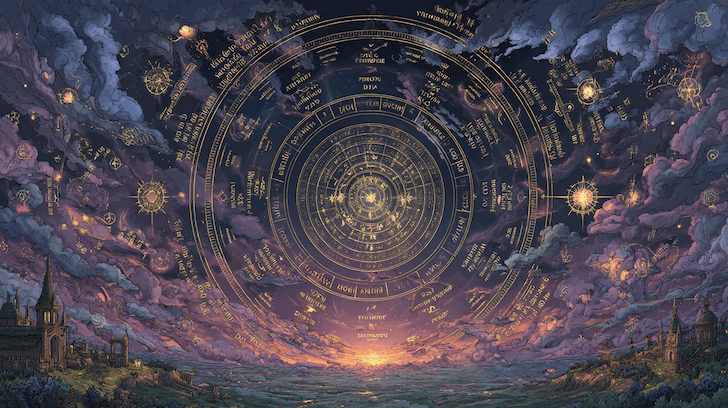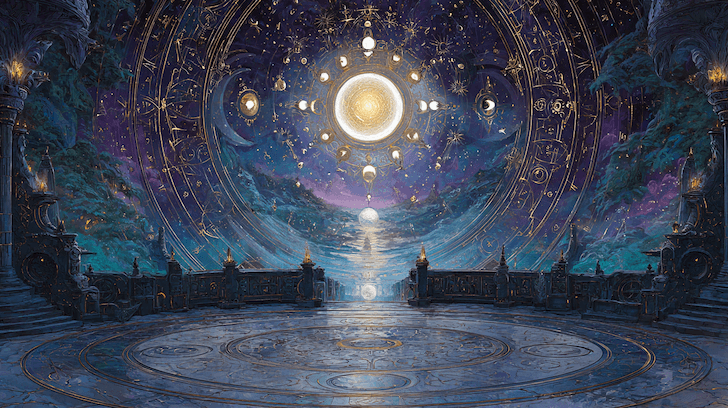How to Find a Chart's Main Theme

A birth chart is a lot of information. The trick is to find the loud signals first and let them organize the rest. You are looking for what repeats, what is angular, and what is tightly connected. The theme emerges where multiple indicators point in the same direction.
Read from loud to soft: angles and rulers → clusters and absences → luminaries and chart ruler → aspects and orbs → elements and modalities → house emphasis. Repetition is your confirmation.
What Counts as Loud
| Signal | Why It Matters | How To Spot It |
|---|---|---|
| Angles and angular planets | The angles are the chart’s speakers | Planets near Asc, MC, Desc, IC by tight orb |
| Chart ruler | Routes energy through the chart | Ruler of the Ascendant by sign, house, aspects |
| Luminaries | Core needs and identity | Sun and Moon sign/house and their closest aspects |
| Stelliums and clusters | Concentration creates dominance | Three or more planets in one sign or house |
| Tight aspects | Exact geometry is decisive | Conjunctions, squares, oppositions within a few degrees |
| House rulers repeating | Same topic keeps being activated | Multiple rulers funneled to one house |
| Element and modality balance | Style of acting and coping | Overweight Fire/Earth/Air/Water or Cardinal/Fixed/Mutable |
| Absences and empty quadrants | What the chart does not lean on | Large gaps by sign, element, or hemisphere |
A Simple Reading Workflow
- Mark the angles. Note planets conjunct the Ascendant, Descendant, Midheaven, or IC. Angular planets are headline material.
- Find the chart ruler. Identify the Ascendant’s planetary ruler, then read its sign, house, and aspects.
- This is your baseline tone.
- Read the Sun and Moon. Note their houses and one or two tight aspects each. These are the needs you cannot ignore.
- Scan for clusters. Stelliums or sign and house pileups show where life concentrates. Name the shared topic.
- Trace the rulers. Follow the rulers of the 1st, 10th, 7th, 4th, 2nd, and 6th to see where they land.
- Repetition reveals the main arena.
- Circle exact aspects. Prioritize conjunctions, squares, and oppositions under a tight orb—especially if they involve luminaries, angles, or the chart ruler.
- Check element and modality. Overweight elements show coping style; modalities show pacing. This colors the whole reading.
- Name the thesis in one sentence. Combine topic, style, and tension into a clean headline.
Rulers and Routing
The signs on house cusps tell you which planet “owns” the topics in that house. Where those rulers end up by house shows where energy is routed.
| House Focus | Follow This Ruler | Theme Routing Clues |
|---|---|---|
| Identity and direction | Ascendant ruler | Where the life-force naturally goes |
| Public role and vocation | 10th ruler | Which arena becomes visible and rewarded |
| Partnership and contracts | 7th ruler | How relationship stories are shaped |
| Home and foundations | 4th ruler | Roots, base of operations, private life |
| Money and livelihood | 2nd ruler | Income mechanics and value expression |
| Workflows and health | 6th ruler | Daily systems, service, strain points |
- Look for convergence. If several key rulers fall into the same house, that house is central to the chart’s story.
- Read condition. A ruler that is angular, dignified, or supported by benefics operates smoothly; one heavily challenged may demand skill-building.
Aspects and Orbs that Decide Tone
- Conjunctions are mergers. Two functions operate as one—loud and defining when close to angles or luminaries.
- Squares are engines. They create friction that demands action. Name the skill the square is asking for.
- Oppositions are axes. They require rhythm and balance across life areas.
- Trines are fluency. Gifts that need intention to be used fully.
- Sextiles are opportunities. Small actions unlock them.
Keep orbs tight when naming a main theme. Aim for under 6° for major aspects, tighter for minor bodies. Luminaries and angles can justify slightly wider orbs.
Clusters, Absences, and Emphasis
- Stelliums and pileups: Three or more planets in a sign or house concentrate life there. That sign’s ruler becomes extra important.
- Empty does not mean silent: An empty house still speaks through its ruler’s placement and aspects.
- Quadrant and hemisphere: Eastern focus leans self-directed; western leans relational.
- Southern favors visibility; northern favors privacy and foundation.
Elements and Modalities as Style
| Element Emphasis | Work Style | Watch For |
|---|---|---|
| Fire heavy | Initiate, inspire, move fast | Sustainability and listening |
| Earth heavy | Build, maintain, prove value | Rigidity or over-caution |
| Air heavy | Connect, explain, strategize | Scattering or detachment |
| Water heavy | Feel, bond, protect | Over-merging or mood loops |
| Modality Emphasis | Tempo | Skill To Add |
|---|---|---|
| Cardinal | Starts and drives | Follow-through and pacing |
| Fixed | Stabilizes and deepens | Flexibility and timing changes |
| Mutable | Adapts and translates | Boundaries and focus |
Putting It All Together
- Topic. Which houses and rulers repeat a setting or life arena?
- Style. Which element and modality dominate the expression?
- Tension or gift. Which tight aspect sets the lesson or opens the door?
- Voice. Which planet is angular or acting as chart ruler to deliver the story?
- Sentence. Combine the four into one headline you can test against lived experience.
A strong theme is usually three ingredients repeating: a house focus, a planetary voice, and a tight aspect. Name these first and the rest of the chart will snap into place.
Quick Theme Starters
| If You See | Likely Theme | First Questions To Ask |
|---|---|---|
| Angular Saturn with tight aspects | Structure and mastery through tests | Where are you building standards and boundaries? |
| Stellium in the 9th | Meaning, travel, teaching, publishing | What philosophy or field are you carrying into the world? |
| Chart ruler in the 10th | Public role front and center | What work wants visibility and responsibility? |
| Sun or Moon ruled by Mars with squares | Action and courage under pressure | Where does initiative meet resistance that becomes skill? |
| Heavy Water with 7th emphasis | Deep relating and protection themes | How do you set care boundaries while staying open? |
When you read for theme, you are not hunting for every detail—you are choosing the through line. Angles, rulers, luminaries, clusters, and exact aspects will tell you the headline. Everything else is supporting cast.
Rulerships in Astrology

What Are Orbs in Astrology?

What Are Aspects in Astrology?

Get Your Birth Chart
Calculate your complete astrological chart with precise astronomical data based on your birth time and location
Generate Chart